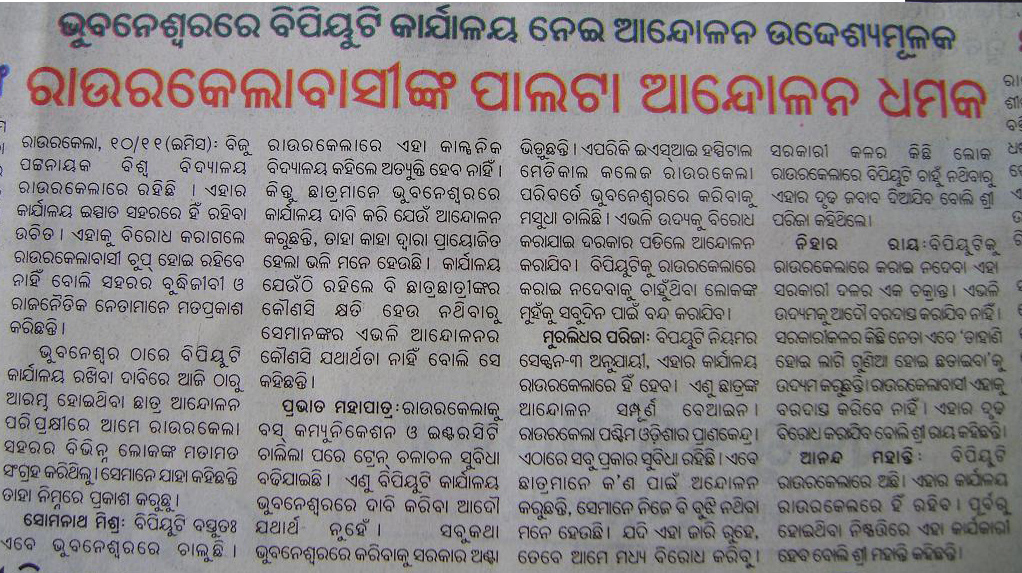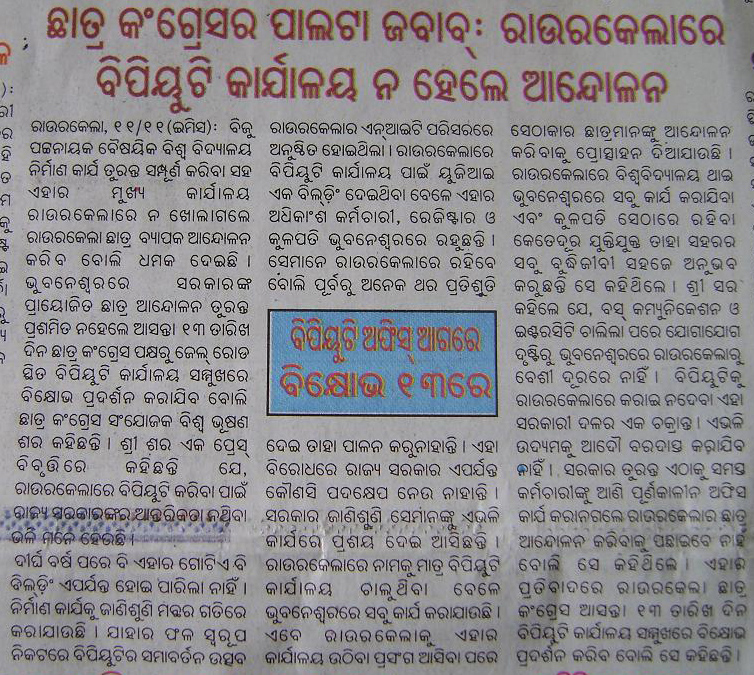Archive for November, 2009
Update: See also https://www.orissalinks.com/orissagrowth/archives/4308.
Rourkela is the second largest metropolitan area of Orissa with an official metropolitan population of 550,668 but perhaps much more (at least 700 K) if one takes into account nearby places like Biramitrapur and Rajgangpur. It is probably the most cosmopolitan area of Orissa. Because of its steel plant it has world-wide name recognition. It has a lot of young talents; I am told that Rourkela youngsters have done much better in entrance exams like IIT JEE than from other parts of Orissa. Rourkela and the Sundergarh district have produced many national hockey players (both male and female), some of whom have gone on to captain the Indian national side.
Being an important station in the Mumbai-Howrah line, Rourkela is very well connected to both. The National Institute of Technology at Rourkela is often ranked among the top 5 NITs of the country; in recent years it has done much better and is in the process of starting a business program. Rourkela also has two private engineering colleges and at least one more is in the works. Rourkela has at least two good magament schools: Rourkela Institute of Management Studies (sometimes ranked nationally) and Indian Institute of Production Management, Kansbahal.
Overall, Rourkela has the potential to be a Tier II city of India at the level of Vizag, Chandigarh, etc. But unfortunately, that has not happened so far and active organized efforts need to be made to achieve that.
So here I will list some of the things that should be pursued so that Rourkela becomes a Tier II city of India.
Knowledge and HRD aspects:
- Metropolitan University: Rourkela is perhaps the largest metropolitan area of the country, or may be the whole world which does not have a general university. This needs to be rectified at the earliest. IMHO, the best model to follow would be of Delhi University. So a Rourkela Metropolitan University should be established with graduate programs as well as with a few constituent colleges spread (offering Bachelors as well as Masters degrees) across the metropolitan area, but with no affiliated colleges. The exisiting government colleges in Rourkela (Govt. College, Rourkela; SG Women’s, Rourkela and Rourkela College) would be made constituents of this university.
- Medical College: Although a WODC sponsored PPP-based medical college is in the works, we must continue pursuing an ESIC medical college here. SAIL, which is making a medical college in Bokaro, should also be pushed to establish a medical college here.
- BPUT: BPUT must become fully operational from Rourkela.It needs to have real departments and centers and offer its own courses. It should be expanded to have programs in Science and Humanities.
- Research Centers: The state should pursue one of the central government departments such as CSIR, DAE, Sc & Tech, etc. to open a research center in Rourkela.
- Centrally funded University: At some point a centrally funded university should be pursued for Rourkela.
- More private institutions: Rourkela has the population base and the amenities that metropolitan areas offer to have more private institutions such as engineering colleges, management institutions etc. A multi-pronged apporoach should be taken.
- Local big industries should be cajoled to participate in this. For example, SAIL is also planning an engineering college in Bokaro. They should be pushed to have one in Rourkela.
- Local people should also open private institutions on their own.
- Educational foundations inside and outside state that have developed good private institutions should be approached and invited to open institutions in Rourkela. Inside Orissa, institutions like Silicon and NIST should be approached.
- STP: The STP at Rourkela should be expanded.
- IT/BPO: Because of the cosmopolitan nature of Rourkela, it would be a good place for BPO and call center operations. This should be pursued.
- Sports Institute/University: Sundergrah district is considered by many to be the Hockey cradle of India, both in men’s and women’s hockey. It has produced both Men’s and Women’s hockey team captains in Dilip Tirkey and Jyoti Sunita Kullu. Orissa government should pursue to establish a National Sports Institute (of the kind in Patiala) in Rourkela. It should include programs in physical training, coach training, official training etc. This would specially contribute in the enhancing the employment opportunities for Adivasis who constitute 50.74% of Sundergarh’s population.
Connectivity Aspects:
- Rail Connectivity -Trains: While the connectivity to Mumbai and Kolkata is marvelous, connectivity to other places needs improvement. Dilip has a good list of new trains needed for Rourkela at http://rourkelarail.wetpaint.com/page/DEMANDS. This list is:
- Rourkela-Bhubaneswar Intercity Express( Day Time)
- Rourkela-Berhampur Gajapati Express
- Rourkela-Secundarabad/Hyderabad Express
- Trains to New Delhi from Bhubaneswar via Rourkela OR Rourkela-Nizamuddin/New Delhi Express (Any extension of Ranchi-Hatia or Tatanagar trains will also work)
- Trains to Patna and Eastern U.P.
- Rail Connectivity-Others: The Talcher-Bimlagarh line must be fast-tracked.
- Roads: The 4-laning of the state highway 10 connecting Sambalpur and Rourkela must be expedited.
- Air Connectivity: Rourkela airport must be made functional with commercial flights at the earliest.
Metro area:
- A larger metropolitan area for Rourkela that includes Kansbahal and Rajgangpur in the west and Biramitrapur in the North must be formally established.
- The state government should pursue Rourkela to be included in JNNURM.
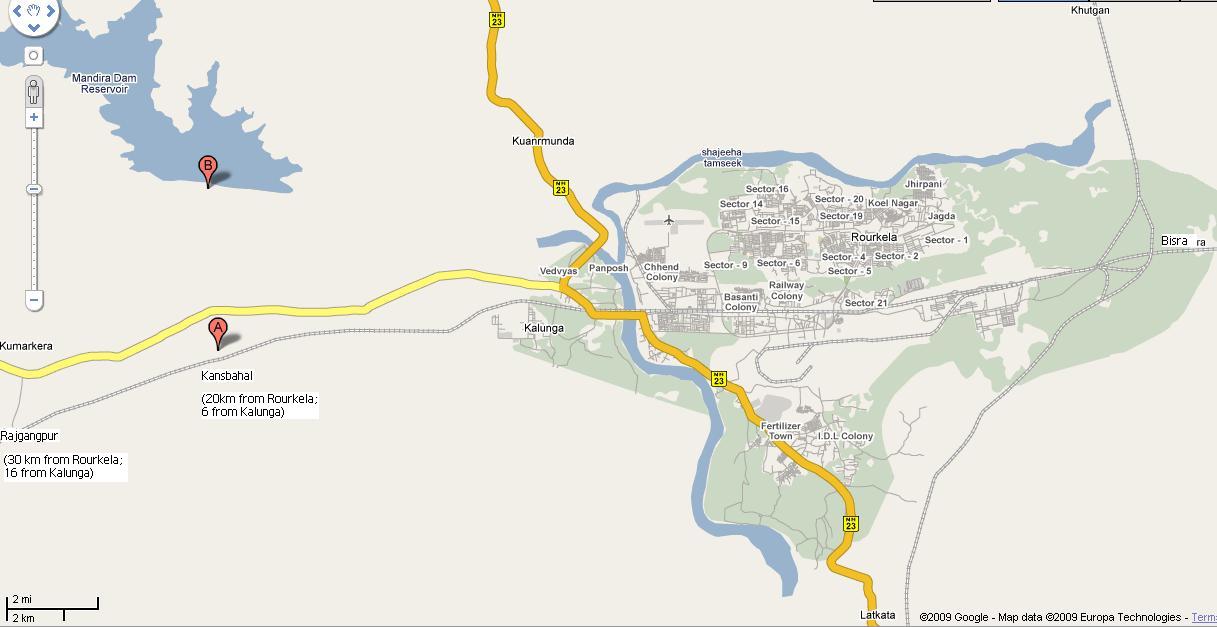
(The above is from Google Maps.)
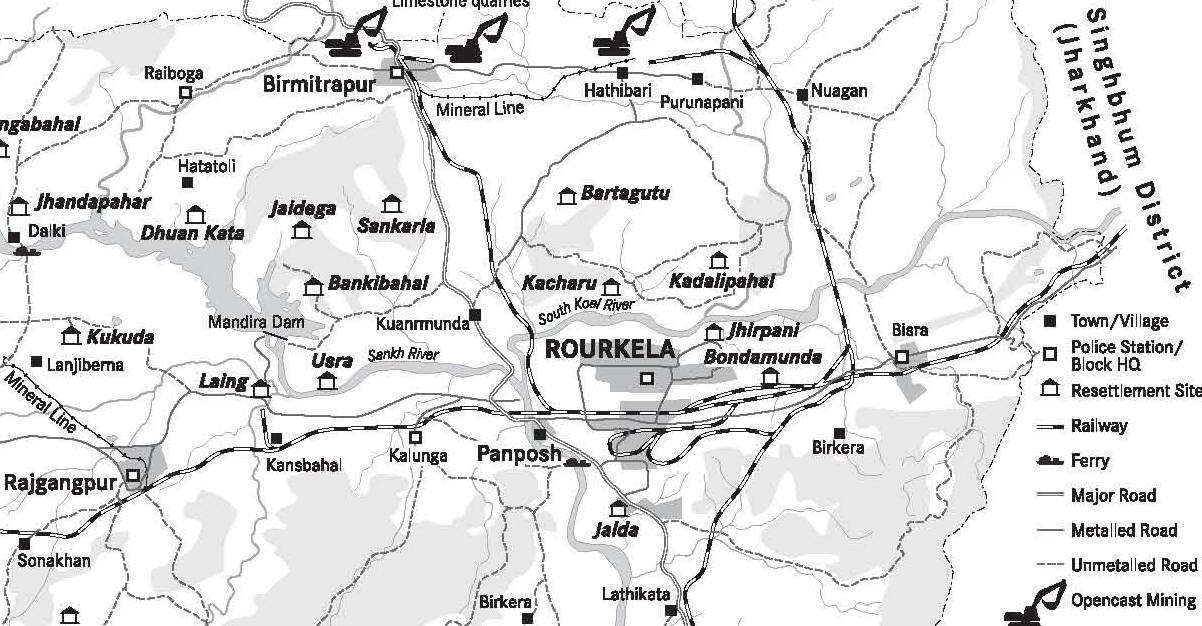
(The above is from "sarini: Occasional papers, No. 4, Adivasis of Rourkela")
Work in Progress…
November 15th, 2009
Update: A Business Standard report has some additional information on this. Following are some excerpts.
International Management Institute (IMI), a New Delhi-based B-school, will invest Rs 50-crore in setting up its campus on 15.8 acres of land at Gothpatna on the outskirts of the city.
… Initially, IMI-Bhubaneswar would have an intake of 60 students for the Post Graduate Diploma in Management (PGDM) programme which will be introduced from July 2010.
To start with, there would be 10 full-time faculty members besides visiting faculty for the maiden PGDM batch of IMI-Bhubaneswar. IMI-Bhubaneswar would have a maximum student intake of 500 and a pool of 50 full-time faculty members once it is fully commissioned after four years. Addressing media persons here, C S Venkata Ratnam, director, IMI-New Delhi said, “We will commence our first PGDM programme at the Bhubaneswar campus from July 2010. The campus will be fully residential with a separate hostel for working executives.”
Students will have to pay around Rs 10 lakh for pursuing the full-time management programme which includes the cost of the hostel. Apart from PGDM programme, the Bhubaneswar campus of IMI would offer executive PGDM programme for working executives. Plans are also afoot to introduce a porgramme in services marketing.
Following is an excerpt from a report in Economic Times.
New Delhi
: Commemorating its 30th anniversary during 2010-2011, the International Management Institute (IMI), New Delhi, has announced the launch of its second campus at Bhubaneshwar in Orissa. Located at the IDCO Institutional area in Gothapatna, Bhubaneshwar, adjacent to IIIT, Bhubaneshwar and NALCO Research Centre, the new campus is spread over 16 acres of land.
Speaking on the occasion, C.S. Venkata Ratnam, director, IMI New Delhi, said, “Subject to getting approval from AICTE, we will commence the first PGDM program in July-Aug 2010.” The campus will be fully residential and function as an autonomous business school. “Besides PGDM programs, IMI Bhubaneshwar will also have centers for research and executive education,” he further added.
… The new campus will also focus on entrepreneurship development and applied research on public policy into socio-economic issues and best practices in management and governance.
Prof N C Patnaik, IMI, said “We plan to be operational in a short span of 8 months, and the building will reflect the Architecture of Orissa.”
IMI Delhi is among the top business schools in India. I hope the Bhubaneswar campus will achieve similar or greater success.
November 13th, 2009
Following is an article written by respected (I respect him a lot) columnist Sharat Kumar Rout. I found it at http://www.orissadiary.com/ShowOriyaColumn.asp?id=15350.
Vedanta University in Orissa: A victim of selfish politicking
Sharat Kumar Rout
Recently, the central team of a political party visited the Vedanta University project site near Puri and participated in a meeting of the group opposed to the project. The team leaders flayed the BJD government of Orissa to their hearts’ content and declared their firm opposition to the University project. They criticised the state government vehemently for giving away ‘prime agricultural land’ at ‘throw-away’ prices for the proposed University, expressed ‘shock’ at selling of Lord Jagannath’s land for the same purpose and also questioned the very logic behind establishment of a world class University in the Puri-Konark area. Well, they came, they saw and went away happily, believing perhaps that they conquered too. But, apart from providing some grist for the media mill, the whole exercise has gained nothing for the party concerned. What actually has come to fore is its glaring double standards. Inviting this mega University project to Orissa in 2006 was the decision of the erstwhile coalition Government in which three important Ministers, namely, law, Revenue and Higher Education, were from the said political party. Obviously, departments under these three Ministers played a very proactive role as far as the University MOU and the related matters were concerned. For all one knows, these particular Ministers were the main votaries of the University project. The central team of this party is surely not unaware of this fact. But now, because of the political dynamics before and after the last election, the party is no longer in the Government and so, it has just decided to play the role of the opposition to the hilt! This, among other things, clearly underscores the overly political nature of the opposition to Vedanta University project.
If one closely follows the anti-Vedanta University opponents and their modus operandi, it will be apparent that out of the 18 revenue villages coming within the proposed University site, only one particular group of people belonging to a particular village has been at the forefront. That they were never against the University project at the beginning and have been brainwashed by some local politicians to form an antagonist group, is also common knowledge. But this anti-Vedanta University group and its local political leaders have been emboldened over the last two years, because of the sustained support of different political parties, groups and personalities who, for various reasons, are opposed to the Naveen Pattnaik- led Government of Orissa. These political vested interests have naturally been able to create a whole lot of hype and hoopla about an anti-Vedanta University ‘movement’ and this, in turn, has been occupying so much of media space and time The usual shouting brigade consisting of the foreign-funded NGOs, their high-flying activists and the celebrity ambassadors they manage to rope in, has only made matters worse. Irrespective of the merit or propriety of the project opponents’ remonstrations, they succeed in creating or increasing doubt in public mind. The intelligentsia is also easily swayed by the media hype, more so because, in these stressful times no one practically has the time or inclination to be properly informed or think about any particular issue no matter how important it is for the society or the country at large. The cumulative result is that fear, suspicion or anxiety of the local community, whose life will be affected directly or indirectly by the project, is intensified creating more elbow-room for further politicking and the project work is delayed.
It is not to say that the people of the project area do not have any genuine grievances. But, surely there are ways and means of taking care of the grievances without stopping the project work. Besides, if the compensation package for land acquisition and other benefits to be made available to the land losers as per the R&R policy are dispassionately analysed, one can very well see that the possible pros far outweigh the cons. And, it will also be clear that most of the allegations of the project opponents are unfounded and unreal. It is high time that the intelligentsia, the youth, the student community and especially, the impartial opinion makers, shunned the shenanigans of the self-serving politicians and raised their voice in favour of the early establishment of a world class University in our state. It is learnt that an IIT could not be established in our state in the 60’s, due to the lack of foresight of our political class and the decision makers. Now, after more than four decades, one IIT has come to us. If we let go an opportunity like the Vedanta University now, perhaps we will never get another in the next hundred years.
[Sharat Kumar Rout, columnist, cell No: 9337369448, Maytree Enclave,Naharakanta,Bhubaneswar.]
There is also another recent article by Swati. It is at http://www.merinews.com/article/bjps-dissembling-policy-on-vedanta-raises-eyebrows/15787962.shtml. Although I mostly agree with her point of view, all her write-ups in Merinews have been about Vedanta University.
November 13th, 2009
Following is an excerpt from a report in Pioneer. (A similar version also appears in tathya.in)
Leading non-resident Odia (NRO) Sandip Dasverma continues to bat for an ESI Medical College at Rourkela, though the State Government has turned a blind eye to the demand of the people of the steel city. Thanks to the alleged poor leadership of Rourkela, MLA Sarada Prasad Nayak, who is the Minister of Food and Civil Supplies, the demand has not been heeded by the Government. However, justifying his stand, Dasverma has come out with a detailed memo to the Government.
Dasverma says that Odisha’s development should take into account development of all regions of the State. But such a thought process is sadly missing, for which Rourkela as location of an ESI Medical College is being ignored. And this has resulted in regional resentment and regionalism, warned he.
He says Rourkela should have been recommended for the first ESI Medical College rather than the second by the State Government, as recently reported in the media. With Bhubaneswar being the destination of nine other medical colleges, one more would not mean much to the capital city whereas it would certainly matter a lot for Rourkela, which has none, he argues.
Dasverma further adds that Rourkela has the main concentration of Employees’ State Insurance (ESI) Insured persons, which is about 60 per cent, while the other 40 per cent live in and around Cuttack and Bhubaneswar. Rourkela should, therefore, get the priority as location of an ESI Medical College and Hospital, he strongly feels.
He points out that people of four districts, Sundargarh, Keonjhar, Jharsugda and Sambalpur would benefit due to an ESI Medical College and Hospital at Rourkela. Some more insured persons of the contiguous State of Jharkhand would also be benefitted.
He says Rourkela is the heart of Odisha’s tribal north-west and dotted with dirty mining industries.
The following two pieces appear in Sambada and Dainik Bhaskar. They have been obtained from http://www.odiasamaja.org/esic-medical-college-odia-samaja-odisa-development-teams-official-press-release/.
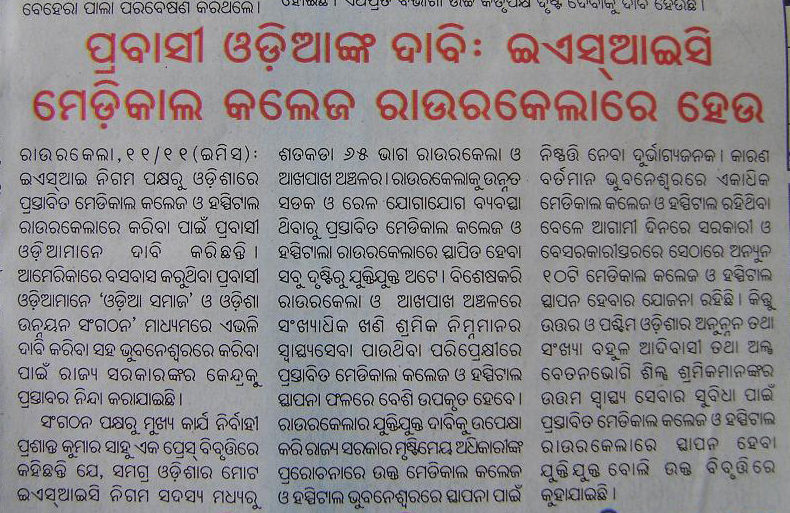
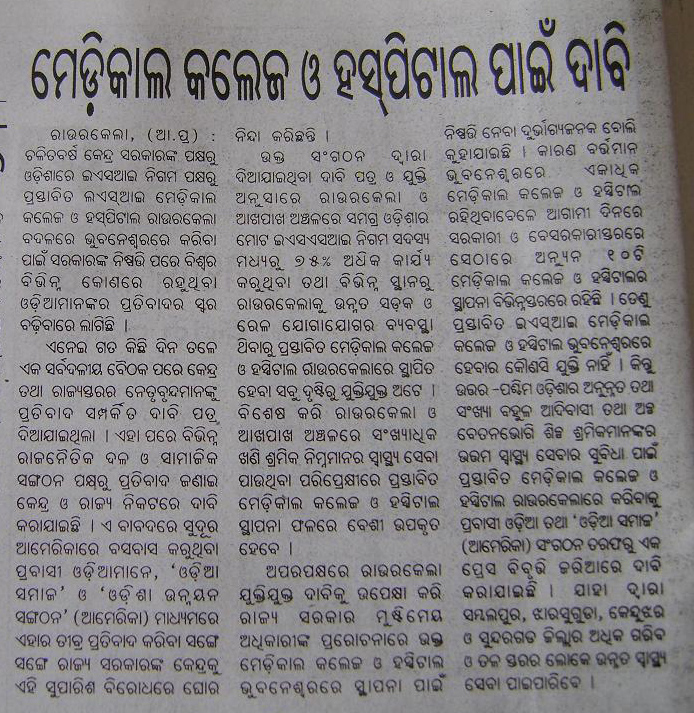
November 13th, 2009
Following is from Today’s Dharitri.
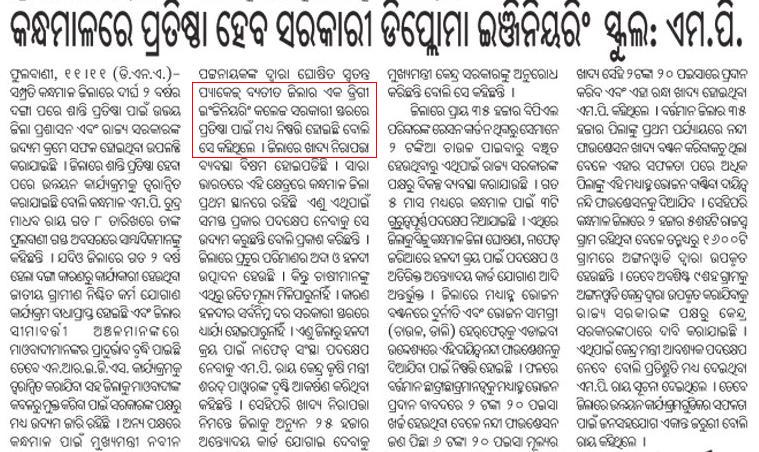
November 12th, 2009
See the table below obtained from http://www.dheorissa.in/DHE/PG.aspx?lnk=Cou.
Continue Reading November 12th, 2009
Following is from the page http://www.dheorissa.in/DHE/Initiatives.aspx?lnk=ini.
To popularise Science education in backward areas Government has decided to open Colleges in the the districts of Malkangiri and Nuapada. Three more Government +2 Science Colleges at Kutra (Sundargarh), Tiring (Mayurbhanj) and Jirang ( Gajapati) are going to be esablished.
November 12th, 2009
Following is an excerpt from a PTI report in Hindu Business Line.
At least three more Apparel Training and Design Centres (ATDC) will be set up in Orissa. The proposed centers will be set up jointly by the Apparel Export Promotion Council (APEC) under union ministry of textiles and state government at Baripada, Cuttack and Sambalpur very soon.
…according to handlooms and textile secretary, Ms Arati Ahuja.
The APEC is now running three ATDCs at Bhubaneswr, Berhampur and Rourkeal with 100 per cent placement guarantee.
… Almost all the students who passed out from the Bhubaneswar centre have got placement, said Ms Lopamudra Das, head of the Bhubaneswar center.
The placement was made in reputed garment companies, she said.
In a related news in Expressbuzz, the recently established Indian Institute of Handloom Technology at Baragarh seems to be going through teething problems. Following is an excerpt.
… The IIHT was established here after much struggle last year as there was an inordinate delay in identifying and handing over the land for the institute. As work on the required infrastructure is far from over, it is now being mooted to hold the final year classes for the IIHT course at Salem. Ever since its inception, the IIHT has been operating on Panchayat College premises here.
As required by the IIHT officials, the institute was provided with classrooms, hostel for students besides four staff quarters. It was hoped that the infrastructure would be readied soon and the institute would be shifted to its new premises at Bhatli Road. But more than a year has passed and only a boundary wall has come up.
… Meanwhile, District Collector Suresh Prasad Padhy has apprised the Secretary, Higher Education of the slow pace of work at IIHT which is likely to be completed by 2013. …
November 10th, 2009
Thanks to Kanhu Roul for the pointer. The following is an excerpt from http://www.mbauniverse.com/aspirantinn.php?id=2534.
The Birla Institute of Management Technology (BIMTECH) held its 21st Annual Convocation on Saturday, November 7, 2009 at the Greater Noida campus of the MBA institute. The Chief Guest was the former President of India, Bharat Ratna Dr. A.P.J Abdul Kalam.
The Convocation ceremony started with the welcome address by Jayashree Mohta, Chairperson, Board of Governors, BIMTECH.
Speaking on the occasion, Dr. Harivansh Chaturvedi, Director, BIMTECH, informed that the institute is planning to open new campuses in Bhubaneswar, Orissa and Sonepat, Haryana.
Said Dr Chaturvedi, “I am glad to report that we have been invited by two state governments, Haryana and Orissa to open campuses in their states. BIMTECH has been recently allotted 29 acres of land at Bhubaneswar, Orissa and 7.5 acres at Sonepat, Haryana.” …
BIMTECH is decently ranked among private management institutes. I think this is different from the BITS Pilani group which planned to establish an IIM type institute and both Orissa government and AP government had pursued it. Orissa was also pursuing a BITS Pilani campus. I don’t know what happened to that. Two years back when we and the CM contacted Sir KK Birla about it we received individual responses which suggested that we wait till BITS-Pilani Hyderabad is operational. Now that BITS-Pilani Hyderabad is operational, I think it is time to broach the topic again with the right people. (Sir Birla has since then gone to the heavenly abode and since then Mr. Kumar Mangalam Birla is in charge of BITS Pilani.)
November 10th, 2009
Following is from http://www.ficci.com/events/20009/ISP/richard.pdf.
Minister SibaI, Mr. Singhani, Mr. Mittal, Dr. Mitra, distinguished guests:
It is a great pleasure to be with you this morning, and an honor to have the opportunity to address this distinguished audience, filled as it is with a diverse and accomplished group of leaders from across India. I thank you for the opportunity.
Over the next two days, you will hear about many of the most pressing issues facing higher education in India, issues that are also challenging universities in the United States and across the globe: reforming regulation and accreditation; using technology; ensuring afford ability; and promoting publicprivate cooperation. All of these issues present opportunities to improve our universities and further the good work they do in society.
It is an honor to have with us today the Union Minister for Human Resource Development, Kapil Sibal.
Only a week ago, Minister Sibal visited Yale, and I was pleased to learn about his ambitious vision for higher education in India. He has shown intrepid leadership in fashioning the Ministry’s plans for new world-class universities, and for making the challenge of improving India’s higher education system a national priority.
There is no doubt that India possesses a number of educational institutions that have made their mark, and will continue to make their mark, on the world stage. The Indian Institutes of Technology, the Indian Institute of Science, and the Indian Institutes of Management are among these. But the rise of this country to become one of world’s economic powerhouses begs for expansion in India’s higher education system. The need is a striking one. India is already the world’s largest democracy. In two decades, it will be the most populated country in the planet, and by 2050, it is likely to become the second largest economy in the world.
We hear much about today’s "knowledge economy,” and for good reason: it is the innovation born at the world’s great universities – and the leaders who are trained there – that will drive the economic growth and continued prosperity of India and the world’s other leading economies in the coming decades.
With this in mind, Minister Sibal and the Indian government have rightly set the dual goals of increasing access to higher education and creating a group of new, worldclass universities. Today, only 12 percent of college-age Indian students pursue higher education. By contrast, in the United States, 63 percent of students go to college; among the 30 member countries of the Organisation for Economic Co-operation and Development, the average is 56 percent. Minister Sibal has articulated an ambitious target of 30 percent of Indian students pursuing higher education by 2020.
Increasing access will require the expansion of enrollment at existing institutions and the creation of many new ones at all levels. The new world-class universities will only contribute a small fraction of the required increase in enrollments throughout India, but they will play an especially prominent role in India’s future development.
First, however, these universities must be built, and that is what I will speak about today: the challenge of building world-class universities.
A great research university is not built from the bricks and mortar of its campus, but of the students and scholars who inhabit it, and the discourse and ideas they share. A university exists not for the purpose of handing out diplomas to those who go through its doors, but to advance knowledge and to educate young people to become critical thinkers and society’s leaders. Building a world-class university is far more than a construction project – it is building a community of knowledge, far more than it is building a campus. A world-class university avails its students not just of courses of study, but of an environment that facilitates learning and growth in all areas of human endeavor. The university is composed of many things: a distinguished and engaged faculty; broad library and museum collections; state-of-the-art laboratories and computing resources; and a wide range of extracurricular, cultural and athletic activities, to name just a few essential components.
At the most fundamental level, a world-class university contributes to the world in three ways: through research, through education, and through institutional citizenship.
First, by facilitating advancements in science, technology, and medicine, research universities help spur economic prosperity and the advancement in the health and quality of life in communities across the world.
Second, by educating students, great universities prepare the next generation of leaders, leaders who will be able to tackle new problems and new situations with maturity and flexibility and who see the world with curiosity and an open mind.
Third, by acting as models of institutional citizenship, world-class universities contribute to the betterment of society and instill in their students social responsibility and an appreciation of service to their communities.
Let me discuss each role of the university in turn.
Inspiring innovation
First and foremost, a world-class university must have a world-class faculty. This serves as the backbone of any institution. For a broad, comprehensive university to be considered world-class it must have a faculty that, through its research, is making significant contributions to the advancement of knowledge.
In our "knowledge economy," nations prosper by virtue of their capacity to innovate – to develop and introduce new products, processes, services, and even, new ways of thinking. The extent to which such innovation happens is a function of the continuing advance of science.
As the principal source of basic research, comprehensive universities playa fundamental and irreplaceable role in encouraging economic development and national competitiveness. This basic research is motivated by the quest for intellectual discovery, not some practical objective-but in the long run, it is the wellspring for all commercially oriented research and development. That fact, that fundamental research occurs within the university – rather than in government laboratories, non-teaching research institutes, or private industry – is an essential element of allowing a university to realize its full potential. When researchers are isolated in research institutes, students – especially undergraduates are deprived of exposure to first-rate scientists, their methods, and their research. Absent the best scientists, the quality of teaching will suffer, and the curriculum is less likely to include the most novel thinking and innovative approaches.
World-class research requires substantial resources, and it is important to allocate these resources to produce maximum social benefit. This is one area where America has far outstripped the rest of the world, by allocating its public funding for research not by seniority and not by political give-and-take, but through the strict meritocracy of peer review. India would be well advised to adopt this model.
The research undertaken in universities must not stay in the academic buildings and laboratories where it is born. To drive national innovation, it must move from theory to practice, and the university plays a key role in this process as well. Engagement with industry is a central function of the modem research university, as commercializing faculty inventions benefits both the university and the broader
society.
Training future leaders
Second, just as faculty members contribute, through their scholarship and research, to the intellectual vigor of their nation and the world, they also serve to shape the future leaders of their nation and, again, the world.
The phrase "the knowledge economy" that is so often spoken about would seem to suggest that universities impart to young people what is most obvious – that is, knowledge. But the best universities do not practice the mere transfer of knowledge from teacher to student. They focus not on the mastery of content, but on the development of their students’ capacity for independent, critical thinking.
Universities exist to teach young people how to think, not what to think. The best American universities seek to educate undergraduates not to be experts in a particular field, but to be creative, flexible, and adaptive; to approach problems critically and to collaborate with others to solve them; and to be able to understand different cultures and adapt to new environments. Universities like Yale train undergraduates not for a profession, but for life.
The method of education employed by America’s most selective universities what we know as the "liberal education" of undergraduates – is particularly well suited to preparing students to enter the rapidly-changing modem world. Courses are not principally about a student mastering a body of knowledge, but about that student’s mind being stretched. This must be a guiding light in the creation of a course of study: as many classes as possible should be small, small enough to take shape as active discussions, not as lectures passively attended. Students must be challenged not to memorize, but to analyze. Professors must serve as mentors, as sources of inspiration, not merely as lecturers and graders.
Students, too, should not find their development limited to the classroom. Students at Yale often say that they learn more over meals with their peers in university dining halls than they do in classrooms and lecture halls. In addition, extracurricular activities- producing a play, singing in an a cappella group, writing for a campus publication – help teach skills in teamwork, communication, and collaboration that students later put to use as their careers develop.
Bettering society
Third, a world-class university leads by example, both in its local community and in the-world. Acts of institutional citizenship have benefits on two levels: they represent a positive force for human welfare, and they also inspire students to embrace social responsibility in their own lives. To illustrate this point, I will give examples of institutional citizenship both locally and globally.
When I became Yale’s president in 1993, the city of New Haven had a distinctly negative external image. As soon as I took office, we created a comprehensive strategy to engage with our surrounding community, partnering with public officials and neighborhood groups to better the city in which we live. Our initiatives included an internship program to allow students to work in schools, community service organizations, and local government; a Homebuyer Program to subsidize home purchases by our faculty and staff in neighborhoods around the campus; a concerted effort to spin-off Yale research into commercial ventures, particularly in biotechnology and medicine, and a major investment in the redevelopment of the downtown retail district. As a result of these actions, our community has been dramatically strengthened.
On a more global scale, consider the issue of reducing carbon emissions. The problem of global warming requires a multinational solution, and no solution will succeed without the cooperation of the United States and India. But universities can and should – play an important role in the effort to curtail global warming, both in their research and in setting standards for their own carbon emissions. In 2005, Yale made a commitment to reduce carbon emissions to 10 percent below our 1990 level by the year 2020, which equates to a 43 percent reduction in our 2005 carbon footprint. If the nations of the world were to negotiate such a reduction in carbon emissions later this year at their meeting in Copenhagen, the planet would be much better off.
Of course, we acknowledge that even the most ambitious sustainability efforts at the world’s universities will not have a measurable impact on global carbon emissions. But in keeping with our mission as a teaching institution, we seek to inspire our students and lead by example. And I believe that the collective leadership of the world’s universities on this important issue may very well serve, over time, to make meaningful global cooperation more likely.
Conclusion
There is no doubt that expanding access to higher education in India is an imperative, and Minister Sibal and others should be commended for understanding its importance. Expanding access to higher education will raise the general standard of living and create avenues of upward mobility for the most disadvantaged. With adequate investment of resources, expanding access is an achievable objective; it has been done before, in Europe and Japan following the second World War, and in China within the last eleven years.
But building world-class universities is a Herculean task. It has never been done before in one concerted effort, by one country. And it requires more than money. But if India succeeds, the impact on Indian society and its aspirations to world leadership will be limitless. It is through world-class universities that the seeds of innovation are planted arid the next generation of leaders acquires the capacity to lead. As this dream is pursued, it will be important to ensure that even these elite universities are accessible and affordable, and not merely available to those whose families can pay for it.
The challenge is immense, but the potential gains are commensurate with the challenge. Through their research, teaching, and institutional citizenship, a new set of great universities will strengthen this society, and the people of India – and of the rest of the world – will reap the benefits.
November 9th, 2009
Following is an excerpt from a report in Pioneer.
Chief Minister Naveen Patnaik has given green signal for the RVS Educational Trust to set up the proposed medical college and hospital in Balangir. Approving the recommendations of a high-level committee, he has asked the Western Odisha Development Council (WODC) to go ahead with an MoU for the purpose.
… Coimbatore-based RVS Group of Institutions, led by Dr KV Kuppusamy, is managing 87 educational institutions in the country. … The WODC had invited expression of interest for the medical college and hospital in Balangir last year in view of Shree Balaji Education and Charitable Trust backing out of the project.
The RVS Group would invest at least Rs 100 crore, while the WODC would provide a Rs 10-crore grant and 25 acres of land in Balangir. The medical college would have an intake capacity of 100 with a 300-bed hospital at its initial stage. Subsequently it would be enhanced to a 500-bed hospital and gradually to a 1,000-bed super speciality hospital, said sources in the WODC.
November 8th, 2009
Update:
HRD Minister Mr. Kapil Sibal spent last several days in the US trying to convince top US universities to collaborate and open branches in India. His talk at MIT is here http://techtv.mit.edu/tags/5218-sibal/videos/4310-mit-india-forum-2009. (Thanks to a commentator at Abi’s blog for the pointer.)
I wish some people of Orissa had not created road block for Vedanta University. If it had made progress as scheduled then it would have put the Bhubaneswar-Puri area in the map of top knowledge centers of India and there would have been a higher chance of some good foreign (especially US) universities thinking about having some operations in Orissa. As it stands now Orissa may lose the window of opportunity it has. Unless Orissa quickly positions itself among the top knowledge centers of India, the top foreign universities will give it a skip and it may again take a long long time for Orissa to catch up.
November 5th, 2009
Following is a letter that Dr. Karmee has sent to many people. This is an excellent work. It is well researched and based on something unique to the location, the Gandhamardan Hills of Baragarh and Balangir. (Considering that many in Orissa may not be aware of Gandhamardan Hills being in Orissa and/or its medicinal values, I have a companion piece on it at https://www.orissalinks.com/orissagrowth/archives/2776.)
I hope others will also focus on unique aspects and attributes of other parts of orissa and write to the higher education task force (HETF) about it.
Respected Mr. Patnaik, CM of Odisha and Members of the Higher Education Task force,
I appreciate the formation of higher education task force by the state government. Also, I am hopeful that such innovative steps will definitely sharpen the higher education of Odisha.
Sirs,
I would like to request the higher education task force to recommend the establishment of a “National Institute of Ayurveda” in Gandhamardan area in western Odisha. I am sure many of us are aware of the potential of Gandhamardan mountain and medicinal plants in it.
In this document, I am presenting the details about the “Gamdhamardan mountain as a reservoir of medicinal plants” with scientific references; thereby, making a case for the establishment of a National Institute of Ayurveda.
I am sure our respected CM, who is the author of the “Garden of Life: An introduction to the Healing Plants of India” will take this matter seriously. Also, I am hopeful that the higher education task force will take the necessary steps; so that, “the medicinal plants in Gamdhamardan mountain” will not get lost with time.
Please have a look on the following write-up for further details.
Thanking you with best regards,
Sanjib
1. “National Institute of Ayurveda” is a must in Gandhamardan area: Introduction and Analysis:
Gandhamardan mountain range is known world wide as a reservoir for medicinal plants. It is located in the western Odisha. More specifically, it is located in between Balangir and Bargarh district (Figure 1).
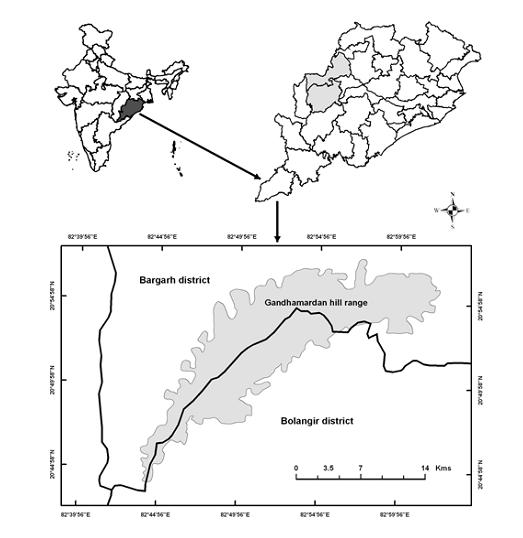
Figure 1 Map showing location of Gandgmardan mountain in between Balangir and Bargarh district
Many eminent scholars of life sciences have done a lot of research on the medicinal plants available in this mountain range. In fact, this hill range is legendary. It has found a place in folklore and mythology -of how Hanuman plucked Bisalyakarani, a medicinal plant, from this hill to save the life of Laxman in the battle of Lanka in “The Ramayana”. In addition, it is known to the whole world how this hill range was at the centre of one of the most prominent ecological movements, that is, the battle between environmentalists keen on protecting aryurvedic plants and the then state-owned Bharat Aluminium Corporation.
Apart from this, there are many scientific journals and books that are mentioning about the potential of medicinal plants available in Gandhamardan mountain (see the reference list)1-5. The state/central govt must establish a “National Institute of Ayurveda” in this place. Right now, both Balangir and Bargarh (Paikmal) each have one Ayurvedic College. Establishing a national level institute on Ayurvedic Medicine will help to a great extent to these colleges by carrying out research in emerging areas. Recently, research on ayurvedic medicine is attracting considerable attention in India and abroad.
It is important to note that, significant developments have boosted systematic research on different aspects of ayurveda and traditional medicine in India. They include the Golden Triangle project jointly managed by CSIR, ICMR and AYUSH; the New Millennium Indian Technology Leadership Initiative (NMITLI) of CSIR and various schemes of DST and DBT.
Additionally, ayurveda is also entering to the mainstream “Drug Discovery”. Following graph show the growing demand of research on Ayurvedic medicine.
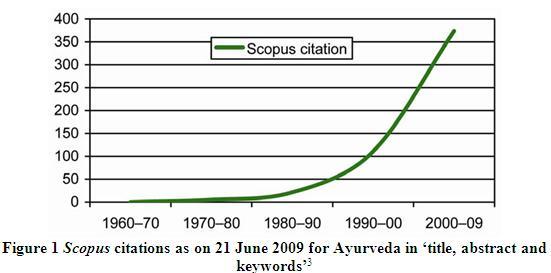
In addition to this, a paper by “Reddy and Pattnaik” from the Forestry and Ecology Division, National Remote Sensing Centre, Hyderabad 500 037, Andhra Pradesh, India points out many interesting facts about “Gandhamardan hill” 4.
It states that, after analyzing and studying the plant resources of Gandhamardan hill range a total of 912 vascular species belonging to 556 genera under 142 families were found. Herbs dominate the flora followed by trees, climbers and shrubs.
Therefore, proper conservation and management plans are needed to save the natural resources, especially medicinal plants, of this sacred hill range. Many botanists fear that this reserve of medicinal plants could be lost in the next few years if proper care is not taken and the indiscriminate collection and smuggling of herbs by local villagers is not stopped. The state forest department which is supposed to guard this botanical wealth is not able to do enough to stop all these developments because they lack of the knowledge and expertise about these plants. In fact, they have no clue which are useful medicinal plants and which are not.
In addition, in these places there is no organized way of farming of the medicinal plants. They just grow in the wild. Therefore, it is very difficult to guard these species. Taking the advantage of this situation any villages or smugglers can walk into the forest and collect the herbs. It is very important that the government should takes steps to grow these plants, harvest these properly, and finally do the marketing of these medicinal plants and herbs in a well organized manner. It should take care of the cultivation and preservation of these plants like it is doing for other forest products like sal seeds or kendu leaves etc.
However, intellectually this problem can be solved by establishment of a National Institute of Ayurveda. The above discussion/ description/ scientific observation strongly suggests the establishment of a National Institute of Ayurveda near Gandhamardan mountain.
2. Following are some of my points in support of establishing a National Institute of Ayurveda in Gandhamardan area:
* West is very much keen on establishing institute on ayurveda. One such successful institution is the National Institute of Ayurvedic Medicine established by Dr. Scott Gerson, USA, (http://niam.com/corp-web/index.htm). This is an example of an institute that has carried out research into Ayurvedic practices to a great extent. In this context, we must use our native expertise. In addition, the National Institute of Ayurvedic Medicine, USA can be a collaborative partner for establishing an institute Gandhamardan area.
* This mountain is very important to all of us and to the world. We should use our natural medicinal resources very judiciously. It is also very surprising that no steps have been taken for the preservation of these high-valued plants. It is the right time to establish a National Institute of Ayurveda in this area.
* As we know this mountain range is a reserve for medicinal plants. Therefore, it will provide adequate environment for cutting edge research/studies in different areas of ayurvedic medicine per international standard.
* Establishment of a National Institute of Ayurveda will help for organized way of farming the medicinal plants; which just grow in the wild. This will also help in preserving different rare species of plants.
* This Institute will provide a boost to the ongoing research/academic activities by Ayurvedic College Balangir and Shri Nrusinghanath Ayurved College Paikmal, Bargarh on this area. Along this line, establishing a National Institute of Ayurveda will make this place a leader in this area of science in national/international level.
* This step will attract companies like Dabur, Ayur, and others to set-up labs/companies in this area.
* From the above discussion it is very clear that research fundings are already available from the leading agencies of India like CSIR (Council for Scientific and Industrial Research), DST (Department of Science & Technology), and DBT (Department of Biotechnology). So, there will be no problem in setting up labs and developing infrastructure.
* There is a lot of synergistic research going on between Ayurvedic, Homeopathic and Allopathic branches of medicine. This is very clear from our day-to-day life as Allopathic doctors often prescribe medicines of Dabur, Neem, etc. Therefore, establishment of such an institute will further enhance the research between this National Institute of Ayurveda with other institutes viz. VSS Medical College, SCB Medical College etc. of the state.
3. The following steps need to be taken to establish a National Institute of Ayurveda in Gandhamardan
* It is important to look in to the web-site of these model Institutes viz. National Institute of Ayurvedic Medicine, USA (http://niam.com/corp-web/index.htm); Gujarat Ayurved University Jamnagar, Gujrat, India (www.ayurveduniversity.com); Rajasthan Ayurved University, Jodhpur Rajasthan (http://www.raujodhpur.org/aboutus.html); National Institute of Ayurved, Jaipur, Rajasthan (http://nia.nic.in/); Ayurvedic university, Hoshiarpur, Punjab; (http://www.financialexpress.com/news/punjab-clears-first-ayurvedic-university-in-hoshiarpur/517911/; This seems to be a new Institute).
* Immediately, the state govt. should present a proposal to the HRD Ministry for establishing National Institute of Ayurveda in Gandhmardan area.
* Along the line of the above institutes, the state govt. in collaboration with govt. of India must establish a National Institute of Ayurveda in Gandhamardan area.
References:
1. Netra Bhanu Pradhan, Gandhamardan – A treasure House of Medical Plants, Navaratna Journal, Jan-Feb, 2008, 41-44.
2. Ayurveda: scientific research and publications, Current Science, 2009, 97( 8), 1117-1122
3. C. Sudhakar Reddy and Chiranjibi Pattanaik, An Assessment of Floristic Diversity of Gandhamardan Hill range, Orissa, India. Bangladesh J. Plant Taxon. 16(1): 29-36, 2009
4. Following are some of the research papers taken from the reference list of the paper 3 (Papers only with the name Gandhamardan are taken)
Brahmam, M. and Saxena, H.O. 1990. Ethnobotany of Gandhamardan hills – Some noteworthy folk medicinal uses. Ethnobotany 2: 71-79.
Brahmam, M. and Saxena, H.O.1990. Phyto-chemical screening of the plants of Gandhamardan hills of Orissa (India) for tannins, saponins, flavonoids and alkaloids. Asian J. Plant Sci. 1: 71-79.
Misra, R.C. 2004. Therapeutic uses of some seeds among the tribals of Gandhamardan hill range, Orissa.Indian J. Traditional Knowledge 3: 105-115.
Misra, R.C. and Behera, G. 1998. Ecological status of Gandhamardan forests using remote sensing techniques. In: Biodiversity Conservation: Problems and Prospects. Proc. National Seminar on Biodiversity Conservation, Bhubaneswar, India, pp. 75-80.
Misra, R.C. and Das, P. 1998. Vegetation status of Nrusinghanath – Harishankar complex, Orissa. J. Econ.Taxon. Bot. 22: 547-554.
Mishra, R.C. and Das, P. 2003. Wild poisonous seeds: Some notable species from Gandhamardan Hill ranges of Orissa. J. Econ. Bot. 27: 513-518.
Misra, R.C. and Das, P. 2004. Vegetation stratification of Gandhamardan hill range, Orissa using remote sensing techniques. J. Econ. Taxon. Bot. 28: 429-438.
Mishra, R.C., Panda, P.C. and Das, P. 1994. Lesser known medicinal uses of plants among the tribals of Gandhamardan hill ranges, Orissa. In: Gupta, B.K. (ed.), Higher Plants of Indian Subcontinent, Vol. III, Bishen Singh Mahendra Pal Singh Publications, Dehra Dun, India, pp. 135-142.
Mishra, R.C., Panda, P.C. and Das, P. 2001. A taxonomic study of the ferns and fern allies of Gandhamardan hills, Orissa. J. Econ. Taxon. Bot. 25: 577-590.
Panigrahi, G. 1963. Gandhamardan Parbat, Orissa – A potential source of important indigenous drugs. Bull. Reg. Res. Lab. 1: 111-116.
Pattanaik, C. and Reddy, C.S. 2007. Medicinal plant resources of Gandhamardan hill range, Orissa: An urgent need for conservation. Natl. Acad. Sci. Lett. 30: 35-38.
Raju, D.C.S. 1960. Vegetation pattern of Gandhamardan hills. Bull. Int. Soc. Trop. Ecol. 1: 21-22.
Saxena, H.O. and Brahmam, M. 1995. Vascular flora of Gandhamardan hills. J. Econ. Taxon. Bot. 19: 113-132.
5. NOTE: This is not the complete list of references. Because of time limitation I have collected as much as I can.
November 4th, 2009
Following in an excerpt from a report in Times of India.
An unemployed MSc or Phd basic science student can write a proposal to the department of science and technology on any project that would have useful results — either in terms of a product or in terms of enhanced knowledge, or new formulations in basic sciences. The proposal is evaluated by experts, and if okayed, the student gets the grant for
two years.
‘‘Students may not want to do an MSc or Phd in basic sciences, fearing they won’t land jobs. This hits research in basic sciences as well as the student ratio and strength. If there is some sort of security and an assured financial support period, students would feel confident to take up MSc or Phd in basic sciences. That way, research benefits,’’ said an official of the department of science and technology.
The ministry is planning an awareness drive across the country on the science allowance.
… ‘‘The money coming from the DST is good and will be enough to help the student coast through a year or two. We expect a student to come up with a project that would be job-enabling, as experience on the project would count in job offers. The good thing is that students would not be penniless for the two-year period. The science ministry takes care of the student until he or she finds a job,’’ the official said.
November 3rd, 2009
Following is from http://www.barandbench.com/index.php?page=brief&id=248&full=.
The National Law University, Orissa (NLUO) was formally inaugurated by the Chief Justice of India, K.G. Balakrishnan. Chief Minister Naveen Patnaik, the Chief Justice of the Orissa High Court, I. M. Quddusi, State Higher Education Minister Debi Prasad Mishra and Minister of Law Bikram Keshari Arukha were present at the ceremony.
Bar & Bench talks to the dynamic Vice Chancellor of National Law University, Orissa, Dr. Faizan Mustafa, on his vision for NLUO and why NLUO is different from the other national law universities (NLUs).
Move from Interdisciplinary approach to integration of knowledge
NLUO is the first University in the country to integrate the B.A., LLB (Hons.) program with the BBA, LLB (Hons.) program. Students can opt for courses from both disciplines of study, and thus, can combine humanities courses with a human resources and marketing course. NLUO has also introduced innovative new courses in legal journalism and mass communication, in conjunction with the law degree.
Students from over 22 states and excellent infrastructure
In the first year, students from 22 states have joined NLUO. Our admission test has been rated as one of the best and some people have said it is tougher than the Common Law Admission Test (CLAT). We hope to receive a better response next year when people see our infrastructure and campus. Currently people think Cuttack is far away from the "Metros" and won’t have good faculty and infrastructure facilities. We have spent more than Rs. 1 crore ($208,000) on the books alone. Our hostel facilities for students are amongst the best. The legal education space in the eastern part of India was in shambles. We hope to make a difference here.
Best of both worlds- Senior Faculty, alumni from NLUs and faculty from foreign law schools
During our times, teachers were good while students were bad, since law was the last option for many students. But with the advent of the national law schools, the quality of students has become excellent. I need thank my Senior from college, Dr. Madhav Menon, for his efforts in bringing change into the legal education space. Self-financing Law Universities like us cannot continue to run without quality faculty. There is an unwritten rule in our Universities where we encourage alumni from other NLUs and people who have taught abroad to come and teach in NLUO. We already have faculty who have had experience in other western countries, along with Senior Faculty from other NLUs. For example, the former Vice Chancellor of NLSIU, Bangalore, Dr. N.L. Mitra is one of the faculty members, as is Senior Professor Ajjappa, who has taught at various Law Universities. We want to bring the best of both worlds together, so students can benefit from such vast experience.
Also, I think Law Faculty should not be judged on UGC or other pay scales in self-financing institutions like ours. We need to provide other incentives to faculty to lure them away from private corporations or high paying jobs. If we have to be a third generation Law University, we need to provide the best for the Faculty and students.
NLUs are producing ‘Soft’ Lawyers
The CJI in his welcome speech said, "The NLUs have failed in so far as producing lawyers for the Bar." Constant criticism against the NLUs is that they are producing ‘Soft’ lawyers who opt for Air Conditioned office spaces instead of joining ‘real ligation’ and or opting for judicial services. If we want to increase the quality of our Judges, we also need to increase the quality of the lawyers. One space where NLUO intends to bridge this divide is to concentrate on "traditional lawyering" and not merely corporate law.
New Areas of Legal Practice
NLUO will focus on mining law, water law, food law, energy law and agriculture law. Our country continues to be driven by agriculture and yet, very little importance is attached to agriculture and the legal issues around it. While Corporate Law and IP Law are important for the economy, equal importance has to be given to other areas of practice. Orissa is losing Rs. 20,000 crores ($4.16 billion) every year due to the center-state divide on resources. We plan to have centers on these areas to conduct exhaustive research and recommendations.
I want to build a socially relevant Law University. I encourage people to come, see the University and provide us with comments on improving it.
November 3rd, 2009
Next Posts
Previous Posts



